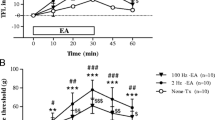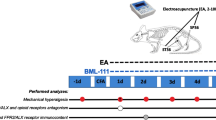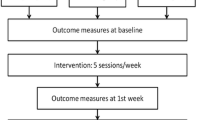Abstract
Electroacupuncture (EA) is widely practiced for the treatment of osteoarthritic (OA) pain, but its therapeutic mechanisms have not yet been fully studied, especially in the experimental OA rat model. In order to induce collagenase-induced arthritis (CIA) in rats, male Sprague–Dawley rats were intra-articularly injected with 0.05 ml of 4 mg/ml collagenase solution in the left knee of the hind limb, followed by a booster injection 4 days later. Maximal gross, histopathological features and biomarker activity changes consistent with human OA characteristics were observed four weeks after the first collagenase injection. In the exploratory preliminary study of EA stimulation parameters, low-frequency train pulse EA stimulation (2 Hz, 0.07 mA, 0.3 ms) delivered to the Zusanli (ST36) acupoint exerted an antinociceptive effect with acupoint specificity in a rat model of CIA. The antinociceptive effect of Zusanli EA was blocked by intraperitoneal pretreatment with naloxone (μ-opioid receptor antagonist, 2 mg/kg) and naltrindole (δ-opioid receptor antagonist, 1 mg/kg), but not with norbinaltophimine (κ-opioid receptor antagonist, 20 mg/kg). The synergistic antinociceptive effects of Zusanli EA were achieved with statistical significance by i.p. pretreatment with DAMGO (μ-opioid receptor agonist, 1 mg/kg) and with [D-Ala2]-Deltorphin II (δ-opioid receptor agonist, 6 mg/kg), but not with (±)-U-50488 (κ-opioid receptor agonist, 3 mg/kg). These results suggest that the 2-Hz EA can attenuate the osteoarthritic pain in CIA, and the analgesic effects of EA can be mediated by μ-opioid and δ-opioid, but not by κ-opioid receptors.






Similar content being viewed by others
References
Das SK, Farooqi A (2008) Osteoarthritis. Best pract Res Clin Rheumatol 22(4):657–675
Poole AR (1999) An introduction to the pathophysiology of osteoarthritis. Front Biosci 4:D662–D670
Goldring MB, Goldring SR (2007) Osteoarthritis. J Cell Physiol 213(3):626–634. doi:10.1002/jcp.21258
Fernandes JC, Martel-Pelletier J, Pelletier J-P (2002) The role of cytokines in osteoarthritis pathophysiology. Biorheology 39(1–2):237–246
Kumar AM, Wen XL (2002) Acupuncture treatment for osteoarthritic pain and inflammation of the knee. Altern Ther Health Med 8(6):126–128
Ng MM, Leung MC, Poon DM (2003) The effects of electro-acupuncture and transcutaneous electrical nerve stimulation on patients with painful osteoarthritic knees: a randomized controlled trial with follow-up evaluation. J Altern Complem Med 9(5):641–649
Sangdee C, Teekachunhatean S, Sananpanich K, Sugandhavesa N, Chiewchantanakit S, Pojchamarnwiputh S, Jayasvasti S (2002) Electroacupuncture versus diclofenac in symptomatic treatment of osteoarthritis of the knee: a randomized controlled trial. BMC complem Altern Med 2:3
Kwon YD, Pittler MH, Ernst E (2006) Acupuncture for peripheral joint osteoarthritis: a systematic review and meta-analysis. Rheumatology 45(11):1331–1337
Selfe TK, Taylor AG (2008) Acupuncture and osteoarthritis of the knee: a review of randomized, controlled trials. Fam Commun Health 31(3):247–254
Ulett GA, Han S, Han JS (1998) Electroacupuncture: mechanisms and clinical application. Biol Psychiatry 44(2):129–138
Ma SX (2004) Neurobiology of acupuncture: toward CAM. Evid Based Complem Alternat Med 1(1):41–47
Gebhart GF (2004) Descending modulation of pain. Neurosci Biobehav Rev 27(8):729–737
Takeshige C, Sato T, Mera T, Hisamitsu T, Fang J (1992) Descending pain inhibitory system involved in acupuncture analgesia. Brain Res Bull 29(5):617–634
Zhao Z-Q (2008) Neural mechanism underlying acupuncture analgesia. Prog Neurobiol 85(4):355–375
Kim HW, Roh DH, Yoon SY, Kang SY, Kwon YB, Han HJ, Lee HJ, Choi SM, Ryu YH, Beitz AJ, Lee JH (2006) The anti-inflammatory effects of low- and high-frequency electroacupuncture are mediated by peripheral opioids in a mouse air pouch inflammation model. J Altern Complem Med 12(1):39–44
Yang EJ, Koo ST, Kim YS, Lee JE, Hwang HS, Lee MS, Choi SM (2010) Contralateral electroacupuncture pretreatment suppresses carrageenan-induced inflammatory pain via the opioid-mu receptor. Rheumatol Int 31(6):725–730
Zhang GG, Yu C, Lee W, Lao L, Ren K, Berman BM (2005) Involvement of peripheral opioid mechanisms in electroacupuncture analgesia. Explore (NY) 1(5):365–371
Lin JG, Chen WL (2008) Acupuncture analgesia: a review of its mechanisms of actions. Am J Chin Med 36(4):635–645
Kim HY, Wang J, Lee I, Kim HK, Chung K, Chung JM (2009) Electroacupuncture suppresses capsaicin-induced secondary hyperalgesia through an endogenous spinal opioid mechanism. Pain 145(3):332–340
Hollander AP, Pidoux I, Reiner A, Rorabeck C, Bourne R, Poole AR (1995) Damage to type II collagen in aging and osteoarthritis starts at the articular surface, originates around chondrocytes, and extends into the cartilage with progressive degeneration. J Clin Invest 96(6):2859–2869
Kikuchi T, Sakuta T, Yamaguchi T (1998) Intra-articular injection of collagenase induces experimental osteoarthritis in mature rabbits. Osteoarthr Cartil 6(3):177–186
de Medeiros MA, Canteras NS, Suchecki D, Mello LE (2003) Analgesia and c-Fos expression in the periaqueductal gray induced by electroacupuncture at the Zusanli point in rats. Brain Res 973(2):196–204
Shen J (2001) Research on the neurophysiological mechanisms of acupuncture: review of selected studies and methodological issues. J Altern Complem Med 7(Suppl 1):S121–S127
Rabinstein AA, Shulman LM (2003) Acupuncture in clinical neurology. Neurologist 9(3):137–148
Millan MJ (2002) Descending control of pain. Prog Neurobiol 66(6):355–474
Han J-S (2004) Acupuncture and endorphins. Neurosci Lett 361(1–3):258–261
Han JS, Tang J, Ren MF, Zhou ZF, Fan SG, Qiu XC (1980) Central neurotransmitters and acupuncture analgesia. Am J Chin Med 8(4):331–348
Zhang RX, Lao L, Wang L, Liu B, Wang X, Ren K, Berman BM (2004) Involvement of opioid receptors in electroacupuncture-produced anti-hyperalgesia in rats with peripheral inflammation. Brain Res 1–2:12–17
Stein C, Lang LJ (2009) Peripheral mechanisms of opioid analgesia. Curr Opin Pharmacol 9(1):3–8
Botter SM, van Osch GJ, Waarsing JH, van der Linden JC, Verhaar JA, Pols HA, van Leeuwen JP, Weinans H (2008) Cartilage damage pattern in relation to subchondral plate thickness in a collagenase-induced model of osteoarthritis. Osteoarthritis Cartilage 16(4):506–514
Huh JE, Baek YH, Kim YJ, Lee JD, Choi DY, Park DS (2009) Protective effects of butanol fraction from Betula platyphyla var. japonica on cartilage alterations in a rabbit collagenase-induced osteoarthritis. J Ethnopharmacol 123(3):515–521
Kim JH, Min BI, Schmidt D, Lee HJ, Park DS (2000) The difference between electroacupuncture only and electroacupuncture with manipulation on analgesia in rats. Neurosci Lett 279(3):149–152
Kim JH, Min B-I, Na HS, Park DS (2004) Relieving effects of electroacupuncture on mechanical allodynia in neuropathic pain model of inferior caudal trunk injury in rat: mediation by spinal opioid receptors. Brain Res 998(2):230–236
Kim SK, Moon HJ, Na HS, Kim KJ, Kim JH, Park JH, Lee SH, Rhim SS, Lee SG, Min BI (2006) The analgesic effects of automatically controlled rotating acupuncture in rats: mediation by endogenous opioid system. J Physiol Sci 56(3):259–262
Yu XJ, Zhan R, Huang H, Ding GH (2008) Analysis on the difference of afferent mechanism of analgesic signals from manual acupuncture and electroacupuncture of “Zusanli” (ST 36). Zhen Ci Yan Jiu 33(5):310–315
Takeshige C (1985) Differentiation between acupuncture and non-acupuncture points by association with analgesia inhibitory system. Acupunct Electrother Res 10(3):195–202
Lund I, Lundeberg T (2006) Are minimal, superficial or sham acupuncture procedures acceptable as inert placebo controls? Acupunct Med 24(1):13–15
Lund I, Naslund J, Lundeberg T (2009) Minimal acupuncture is not a valid placebo control in randomised controlled trials of acupuncture: a physiologist’s perspective. Chin Med 4:1
Na BJ, Jahng GH, Park SU, Jung WS, Moon SK, Park JM, Bae HS (2009) An fMRI study of neuronal specificity of an acupoint: electroacupuncture stimulation of Yanglingquan (GB34) and its sham point. Neurosci Lett 464(1):1–5
Chen XH, Han JS (1992) All three types of opioid receptors in the spinal cord are important for 2/15 Hz electroacupuncture analgesia. Eur J Pharmacol 211(2):203–210
Han J-S (2003) Acupuncture: neuropeptide release produced by electrical stimulation of different frequencies. Trends Neurosci 26(1):17–22
Huang C, Wang Y, Chang JK, Han JS (2000) Endomorphin and mu-opioid receptors in mouse brain mediate the analgesic effect induced by 2 Hz but not 100 Hz electroacupuncture stimulation. Neurosci Lett 294(3):159–162
Acknowledgments
This research was supported by Basic Science Research Program through the National Foundation of Korea (NRF) funded by the Ministry of Education, Science and Technology (2009-0069462).
Conflict of interest
All authors of this manuscript declare that they have no conflict of interest.
Author information
Authors and Affiliations
Corresponding author
Rights and permissions
About this article
Cite this article
Seo, B.K., Park, D.S. & Baek, Y.H. The analgesic effect of electroacupuncture on inflammatory pain in the rat model of collagenase-induced arthritis: mediation by opioidergic receptors. Rheumatol Int 33, 1177–1183 (2013). https://doi.org/10.1007/s00296-012-2502-5
Received:
Accepted:
Published:
Issue Date:
DOI: https://doi.org/10.1007/s00296-012-2502-5




